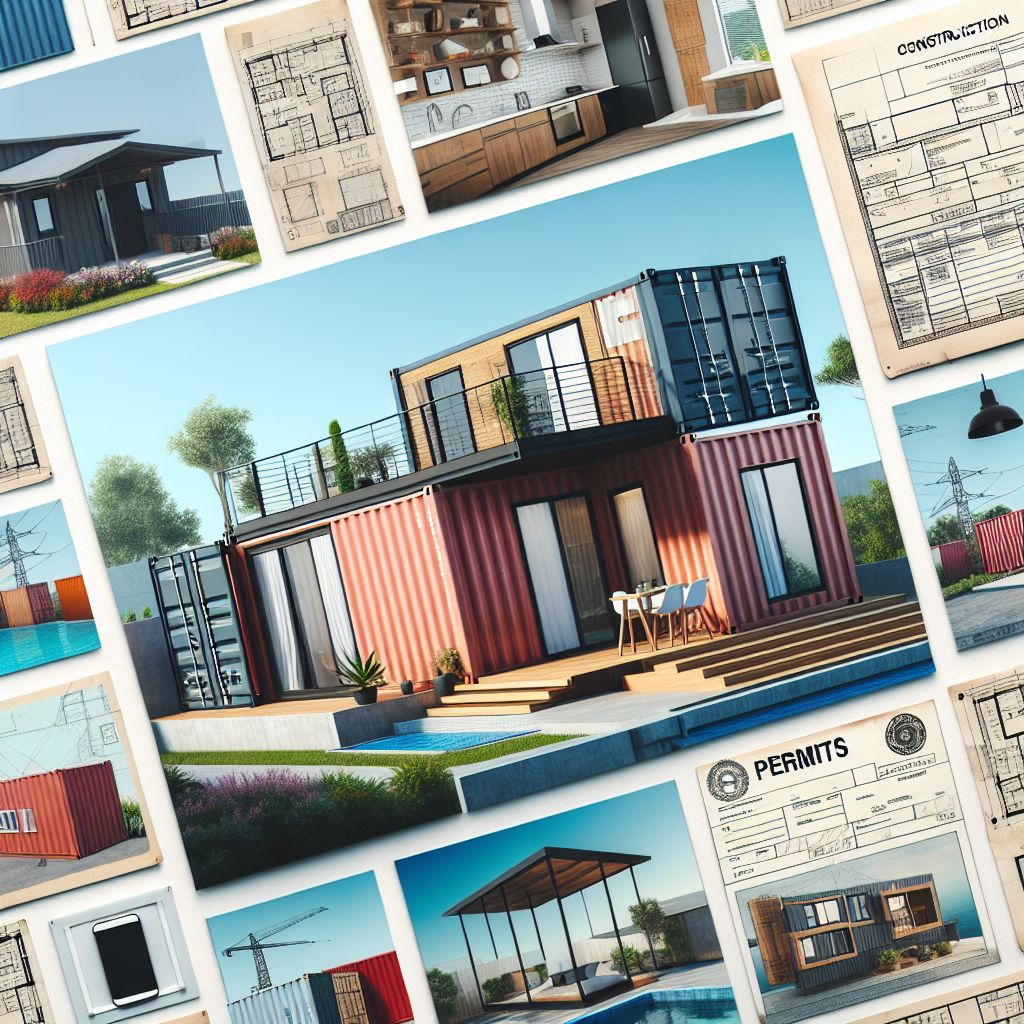
Key Takeaways
- In Washington State, container homes can be a more cost-effective option starting at $20,000
- Container homes often have shorter construction timelines, which can further reduce labor costs.
- Long-term sustainability and lower carbon footprint are significant benefits of container homes, potentially leading to future savings on utilities.
- Zoning regulations and building codes are pivotal in determining the feasibility of constructing a container home in Washington State.
- Choosing the right location for a container home in WA can impact both the cost and the environmental benefits of the build.
Cost Analysis and Expenses: Container vs. Traditional Homes in Washington State
Understanding the financial implications is crucial when considering a container home. Let’s start by comparing the initial costs you’ll encounter.
Breaking Down Initial Construction Costs
Building a home is a significant investment, and the initial construction costs are often the deciding factor for many homebuyers. In
My Favorite Container Homes Resource
I compared the top 3 Container Home Guides
to discover the ultimate resource!
See my top recommendation here
- Material Costs: A used shipping container can range from $1,500 to $5,000, depending on size and condition but will need a lot of additional work. Materials for a traditional home can will normally be a much higher cost.
- Design and Planning: With container homes, you can often utilize pre-designed plans, which cuts down on architectural fees. Traditional homes typically require custom plans, adding to the overall cost.
- Site Preparation: Both types of homes need a foundation, but container homes can sometimes require less extensive groundwork, depending on the design and location.
Let’s put these numbers into perspective with a table that outlines the average costs you might expect.
| Expense | Container Home | Traditional Home |
|---|---|---|
| Materials | $1,500 – $5,000 (per container) | $50,000+ |
| Design/Planning | $1,000 – $5,000 | $10,000+ |
| Site Preparation | $5,000 – $10,000 | $5,000 – $15,000 |
Besides that, container homes offer a unique advantage when it comes to customizing your space. With the money saved on initial construction costs, you can invest in high-quality finishes and eco-friendly additions.
Understanding Ongoing Maintenance and Utility Expenses
After the excitement of building your home, you’ll need to consider the ongoing costs. Container homes are often praised for their durability, which can lead to lower maintenance costs over time. They’re made from corrosion-resistant Corten steel, which stands up well to Washington’s rainy climate.
Moreover, container homes can be more energy-efficient, thanks to their smaller size and the potential for tight
Comparative Study of Financing Options for Homebuyers
Most importantly, financing a container home in Washington State can be different from a traditional home. Some lenders may be hesitant to offer a mortgage for a container home due to their non-traditional nature. However, as container homes gain popularity, more financing options are becoming available.
Whether you choose a container home or a traditional build, it’s essential to shop around for a mortgage that suits your needs and to consider the potential resale value of your home. Container homes are still a relatively new concept, and their market value can vary.
Construction and Labor Considerations
Now, let’s talk about the people who will turn your house from a dream into a reality. The construction process for container homes can be less labor-intensive, which translates to savings for you.
Evaluating Labor Needs for Container Home Projects
Container homes can be assembled much faster than traditional homes, as the main structure is already built. This means you’ll need a smaller crew and a shorter timeframe to complete the job. Because labor costs can be one of the most significant expenses in home building, this efficiency can be a game-changer.
However, it’s important to work with contractors who have experience with container homes. Their expertise can prevent costly mistakes and ensure that your home meets all necessary building codes.
Time Investment: From Site Prep to Move-In Day
The timeline from the start of construction to move-in day is often shorter for container homes. It’s not uncommon for a container home to be habitable within a few months, while traditional home construction can take a year or more. This speedier timeline not only saves on labor costs but also gets you into your new home faster.
Remember, the key to a successful container home project is planning. Careful consideration of design, materials, and the construction process will lead to a smoother build and a home that’s both eco-friendly and economical.
Measuring the Carbon Footprint of Building Materials
When we consider building materials for our homes, it’s not just the cost that matters; it’s also their carbon footprint. Container homes score high in this area because they repurpose steel containers that would otherwise sit unused. This reuse of materials significantly lowers the carbon footprint compared to traditional homes, where new materials are often sourced, produced, and transported, all of which add to the environmental impact.

Regulatory Compliance and Zoning
Navigating the legal landscape is a critical step in the home-building process. For container homes, understanding the specific regulations and zoning laws in Washington State is vital to a successful build.
Understanding the Legal Framework for Home Building
Building a home in Washington State means complying with the International Building Code (IBC), which most local jurisdictions adopt. Both container and traditional homes must adhere to these regulations. However, container homes may face additional scrutiny because they are not as common. It’s crucial to engage with local building departments early in the planning process to ensure all requirements are met.
Overcoming Zoning Challenges for Container Homes
Zoning can be one of the biggest hurdles for container homes. Some areas may have restrictions on the use of shipping containers for residential purposes. Therefore, it’s important to research and possibly petition for zoning variances or amendments. This proactive approach can save time and avoid potential roadblocks.
Summary of Requirements in Washington State
Before you embark on building your container home, familiarize yourself with the requirements in Washington State. The following table summarizes what you need to know:
| Requirement | Container Home | Traditional Home |
|---|---|---|
| Building Codes | Must comply with IBC and local amendments | Must comply with IBC and local amendments |
| Zoning Laws | May need special permits or variances | Generally well-defined |
| Foundation | Pile foundations common | Concrete slab or crawlspace foundations common |
| Utilities | Can integrate off-grid options | Typically on-grid connections |
| Financing | May be more challenging to secure | More traditional mortgage options |
Location-Specific Factors
The choice between a container home and a traditional home can also be influenced by location-specific factors unique to Washington State.
Analyzing the Climate’s Impact on Home Choices
Washington’s diverse climate, ranging from coastal to mountainous regions, can greatly influence the type of home you build. Container homes, with their sturdy steel construction, are well-suited to withstand the state’s varied weather conditions. However, proper insulation is key to making them comfortable year-round.
Determining the Best Sites for Economic Development
Choosing a site for your home isn’t just about the view or the land cost. It’s also about economic development. Areas that are up-and-coming may offer incentives for building sustainable homes, like container homes, which can make them more financially attractive than traditional builds.
Foundation and Structural Integrity
The foundation of your home is as important as the structure itself. Both container and traditional homes require solid foundations, but the approach may differ.
For container homes, the weight is distributed differently, and the foundation must accommodate the unique load points. Traditional homes, with their more uniform weight distribution, might use different foundation types.
Comparing Foundation Requirements for Different Home Types
Let’s look at the typical foundation requirements for each type of home:
- Container homes often use pile foundations, which can be less invasive and quicker to install than traditional foundations.
- Traditional homes typically use concrete slab or crawlspace foundations, which require more extensive excavation and preparation.
Ensuring Stability and Security Against Natural Disasters
Washington State is prone to natural disasters like earthquakes and landslides. The design and construction of your home’s foundation should take these risks into account. Container homes have the advantage of being inherently strong and can be easily reinforced. Traditional homes require careful engineering to achieve the same level of resilience.
- Choose a foundation type that suits the terrain and environmental risks of your site.
- Work with a structural engineer who has experience with container homes to ensure stability.
- Consider the long-term implications of your foundation choice on the durability and safety of your home.
Design and Construction Techniques
Innovation is at the heart of the container home movement. By embracing new design and construction techniques, container homes can push the boundaries of what’s possible in sustainable living.
For example, a container home in Washington might feature:
Rainwater harvesting systems to reduce water usage.
Green roofs or living walls to enhance insulation and biodiversity.
Solar panels or wind turbines for renewable energy generation.
These features not only benefit the environment but also create homes that are self-sufficient and future-proof. Traditional homes can also incorporate these innovations, but the cost may be higher due to the larger scale of the build.
In summary, container homes in Washington State offer an exciting alternative to traditional housing, with potential cost savings, sustainability benefits, and innovative design possibilities. Whether you’re drawn to container homes for their eco-friendliness, affordability, or unique aesthetic, it’s clear that they present a compelling option for homebuyers looking to make a positive impact on both their wallet and the world.
Incorporating Emerging Technologies in Home Design
As we embrace the future of homebuilding, it’s essential to look at the role emerging technologies play in home design. Container homes, with their modular nature, are especially well-suited to integrate smart home systems, advanced insulation materials, and innovative heating and cooling solutions. These technologies not only make your home more comfortable but also reduce energy consumption and long-term costs.
Eco-Friendly Innovations Enhancing Home Efficiency
Eco-friendly innovations are central to the philosophy of container homes. By incorporating features like solar panels, green roofs, and energy-efficient appliances, these homes are at the forefront of eco-conscious living. Traditional homes can also be retrofitted with these technologies, but the compact and modern design of container homes often makes them more adaptable to such enhancements.
Summary Table For Washington State
| Factor | Container Homes | Traditional Homes |
|---|---|---|
| Construction Costs | – Can be 15-50% cheaper than traditional homes – Costs range from $20,000 to $250,000+ depending on size, design, modifications[1][2][3] | – Average $300-$400 per sq ft – Total costs range from $285,000 to $600,000+ for a 1,000-1,500 sq ft home[4] |
| Land Costs | – Land availability and costs can significantly impact overall affordability[2][4][5] | – Land availability and costs can significantly impact overall affordability[2][4][5] |
| Construction Time | – Faster construction, often 4-8 weeks[2][3] | – Slower, more labor-intensive construction[2] |
| Durability & Lifespan | – Corten steel containers are very durable, potential lifespan of 25+ years with proper maintenance[1][3] | – Traditional materials like wood and concrete have a long lifespan if well-maintained[3][4] |
| Energy Efficiency | – Can offer improved energy efficiency compared to traditional homes[1][3] | – Varies based on construction methods and materials used[3][4] |
| Sustainability | – Repurposing shipping containers is more sustainable than new construction[1][4] | – Potential for higher environmental impact depending on materials used[3][4] |
| Regulatory Compliance | – Washington State generally allows container homes, but local regulations vary[1][4] | – Must comply with local zoning and building codes[1][4] |
| Specialized Skills | – Requires experienced builders familiar with container home construction[1][4] | – Can be built by general contractors and builders[2][4] |
Reference Links:
[1] https://homeyou.com/wa/container-homes-seattle-costs
[2] https://www.arcgo-ph.com/container-homes-vs-traditional-homes/
[3] https://www.bhg.com/shipping-container-homes-8303351
[4] https://www.linkedin.com/pulse/container-homes-pros-cons-cost-comparison-kevin-liu
[5] https://www.upnest.com/1/post/cost-build-container-home/
Container homes in Washington State can offer significant cost savings, faster construction, and sustainability benefits compared to traditional homes. However, the overall feasibility and affordability depend on factors like land availability, regulatory compliance, and the level of customization required. Careful planning and working with experienced professionals are crucial for successful container home projects in Washington.

Frequently Asked Questions (FAQ)
What Are the Most Common Misconceptions About Container Homes?
One widespread misconception is that container homes are not as durable as traditional homes. In reality, shipping containers are designed to withstand harsh marine environments, making them incredibly sturdy. Another myth is that container homes are too small or too industrial-looking. With creative design, however, these homes can be spacious and aesthetically pleasing.
Container homes are also mistakenly believed to be significantly cheaper in all aspects. While initial construction costs can be lower, the price of a container home can increase depending on customization and finishes.
Can Container Homes Withstand Extreme Weather Conditions Typical to Washington State?
Container homes are built to endure extreme conditions, thanks to their steel construction and the ability to be easily reinforced. With proper insulation and design, they can withstand Washington State’s varied climate, from heavy rainfall to snowfall in the mountainous regions.
For example, a container home in Washington can be equipped with a robust HVAC system to manage the damp, cool winters and ensure that the interior remains dry and warm, while the durable exterior stands up to the elements.
How Do I Begin the Process of Building a Container Home in Washington State?
The first step is to research and understand the local building codes and zoning laws. Next, find a piece of land and a contractor experienced in container home construction. From there, you can start designing your home, keeping sustainability and efficiency in mind. Don’t forget to explore financing options early in the process.
What Incentives Exist for Building Sustainable Homes in Washington?
Washington State offers various incentives for sustainable building practices, including tax exemptions, rebates, and grants for using renewable energy sources and eco-friendly materials. For more detailed information, you might want to check out this container home guide that discusses building regulations, compliance tips, and financial aid, which could be applicable to your local area.
What Are the Long-Term Savings of Living in a Container Home?
Container homes can provide long-term savings through reduced utility bills, lower maintenance costs, and potential tax incentives for green building practices. The compact size and the possibility of incorporating renewable energy sources further enhance these savings.





